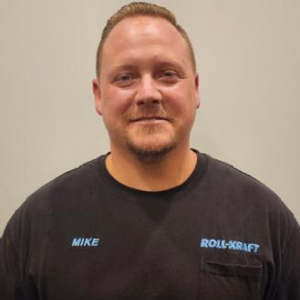Subscribe To Roll-Kraft
Receive the latest news from Roll-Kraft.

Written by: Robert A. Sladky, VP of Tube Mill Engineering
Numerous questions asked lately on our web site have been customers having issues maintaining weld integrity in one form or another.
Some have the weld split right in the center of the seam. Others, off to the side of the weld zone or completely away from the weld zone over into the parent material. Others have issues with clean proper scarfing of the OD and ID of the weld bead.
Some operators feel that if they have a welding issue, the problem has to be at the welding station, when realistically, it could be further upstream in the setup, or possibly the quality of the incoming material, strip width, tooling design, tooling condition, mill integrity, mill alignment, proper setup, and the list goes on.
We have many articles and videos on the subjects outlined above and more in our Resource Center. We will use some of these as support references in this article on “Weld Integrity”, which will expand to the other possible factors that can affect welding performance on a tube/pipe mill.
So let us take time to cover all the “basics”. Any one of these may lead to the resolution of the welding issues many face, but at the very least, it will also serve a good review for all to give their operation/mill/setup a good checkup.
--First off, what is the condition of your tube/pipe mill? Do you have PM (Preventative Maintenance) program for your mills? Every component on a tube mill must be inspected on a regular basis, and maintained between these inspections. If we have a machine with poor integrity, you will be hard pressed to hold and form the strip in a straight line as originally designed by the mill manufacturer and tooling supplier. Below is a video on the importance of a properly maintained PM program for your mill.
At the end of that video, you will be directed to our article entitled: “Preventative Maintenance Programs for Tube, Pipe and Roll Form Mills.” It is one of the most comprehensive Profit Pointer in all of our series, and has at the end of the document, sample PM program forms to enhance your current PM program, or to start a new one.
Whereas the above link for Preventative Maintenance outlines the many important areas to check on the mill, our Resource Center has individual videos, and articles addressing each important component typically found on a tube/pipe mill. Take time to research these valuable articles and videos to assist your maintenance department to “cover all the bases” on your mill. The links below are just a couple of examples:
--Once we are assured that our mill is in good shape, we have to also ensure your tube/pipe mill is in good alignment. The tooling is mounted on your mill stands and forms your product in a straight line. All passes must be aligned, top to bottom, pass to pass, section to section, in a straight line, so the formation does not incur any marking of the tube, wondering or roll over, keeping the seam at the 12 o’clock position so we can properly weld it at the welding station. Alignment needs to include all areas/sections of the tube/pipe mill. Most alignment services are usually performed using lasers, or precision optics. Most mill manufacturers offer this service. However, the following links are some supportive articles to allow your maintenance department to check the basic alignment of your tube/pipe mill themselves with simple tools and procedures.
--Now that we ensured your mill is in good shape, and in alignment, how is the condition of your tube and pipe tooling? Do you have a tooling maintenance program where you can track the wear of your tooling, inspect it between changeovers, and create a threshold when the tooling needs to go in for rework or replacement? Obviously if the tooling is not in good condition, it will have issues trying to form and prepare the strip for welding, even with a properly maintained and aligned mill, and the best setup. To follow are some links to help guide you to creating your own Tooling Maintenance Program, inspection and cleaning procedures.
--Do you have the proper strip width to match the size of tube/pipe, design of the tooling, material type, and type of welding? Too wide of a strip will cause marking and fold over at the weld box. Too narrow of a strip width with not give you enough welding allowance to forge a proper bead. If you are not sure, or have not checked your strip width in a long time, use our “Strip Width Calculator” to verify if your incoming material is at the proper width.
--Do you have top quality incoming material? As the old saying goes, “junk in, junk out”. The tube/pipe mill is not a miracle worker for substandard material. Alternatively, how many times have you been running just fine, and then you switch to another vendor or heat number and it causes welding issues? Our profit pointer, “Handling Incoming Coiled Material” addresses all the key factors that must be addressed to ensure consistent quality incoming material.
--Next will be the setup of the tooling for the size it has been designed to run. Have you documented the setup from the last time you ran this size so you can go back to the same settings you left off with? This saves valuable setup time and minimizes scrap tremendously. Are you setting up the tooling to the setup chart provided by the manufacturer of the tooling, or is it setup by feel, or “the seat of the pants' ' approach? Setup and the formation of a tube/pipe is a science, not an art. Every pass of the tooling on the mill has a specific job to do in contributing to the formation process of the tube. Every pass on a tube mill is in reality, a “Roller Die”, forming a part, one pass at a time, on a continual basis, on a machine called a tube/pipe mill. This requires the operator to measure the formation out of each pass to insure it is producing/contributing to the formation of the tube, as it was originally designed. The following link entitled, “Mill Setup-14 Part Series”, is the longest, most comprehensive tube and pipe mill training video series ever produced, and covers from start to finish the presetting of a mill, threading of the strip, and the measuring of the formation out of each and every pass progressively to insure a proper setup. Each of the 14 part series is individually labeled so you can go back to a specific part of the series and use for return reference.
--Was your weld box set up properly in the first place? Here is a link to a video that outlines, (to illustrate as an example), how to properly set up a three-roll weld box on a High Frequency mill. The same basic guidelines would be used for any style weld box.
In this article on setting up the welding section, we outline some troubleshooting guidelines for split welds.
In closing, we trust that this article helped alleviate the majority of weld problems many of you are experiencing as well as providing a good refresher for the many areas we covered. As noted earlier in this document, make sure to visit our Resource Center for more valuable articles, and videos that are designed to help you help yourself to be the best in your industry.
Looking for answers to tube and pipe questions 24/7?
Click here to contact our team with any questions you may have about tube and pipe weld integrity. One of our technicians will email you an answer or call you for more details.
Simply contact us here or call and get answers 24/7.
Contact Us (888) 953-9400
Roll-Kraft is pleased to announce the appointment of Mr. Mike Samplak to the position of Plant Manager at its headquarters facility in Mentor, OH.

Roll-Kraft is pleased to announce the appointment of Frank Lowery to Vice President of Roll Form Applications.

Roll-Kraft is pleased to announce the appointment of Kevin Gehrisch to the position of President.